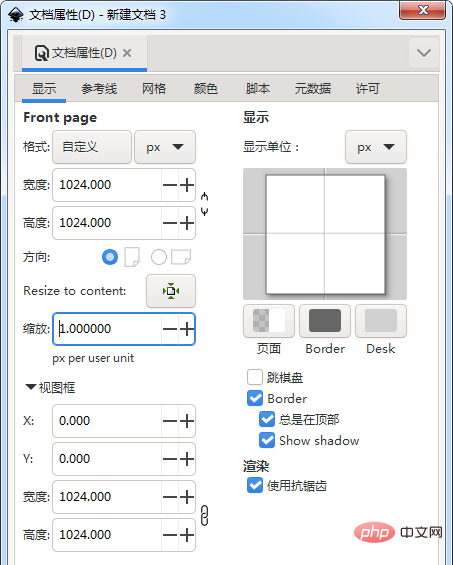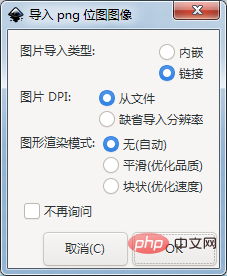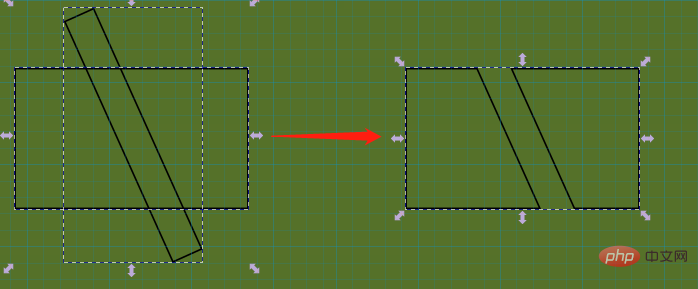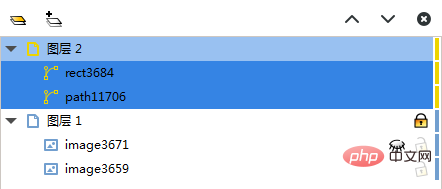 Backend Development
Backend Development
 Python Tutorial
Python Tutorial
 A brief introduction to the python analysis inkscape path data scheme
A brief introduction to the python analysis inkscape path data scheme
A brief introduction to the python analysis inkscape path data scheme
[Related recommendations: Python3 video tutorial ]
Sometimes you need to use path data during the development process, although python has its own svg Or other vector libraries, but this is just for experimental purposes, there is no need to study in depth, so some simple solutions are adopted: use inkscape to generate svg, and then python analyzes and outputs it to achieve the corresponding purpose
inkscape generates the path
Set document properties:

Set grid:

Import png images as reference:

Note that the imported image and document properties have the lower left corner as the origin. :

In the layer and object property bars, modify the image visibility and lock the image:

Create a new layer above the current layer to draw road strength
Draw a rectangle at will and make the corresponding shape. For example, cutting between two rectangles can be done through the menu: Path->Difference set

Convert shape to path
Theoretically, after saving, there is an svg file that can be converted to a path. However, due to the complex format of svg files, there will be various shape data, so here we need to uniformly convert various shapes into paths for simple analysis by python
Then the above example needs to be repeated Further processing:
- If the object is a rect or other shape, execute the menu: Path->Object to Path
- For combination For the shape of the path, execute the menu: Road Jin->Split Road Jin
The final layer obtained is as follows:

##After saving the svg file, open it with Notepad, and you will see the following key content:
<g
inkscape:groupmode="layer"
id="layer2"
inkscape:label="图层 2"><path
style="fill:none;stroke:#000000;stroke-width:0.1;stroke-dasharray:none"
d="m 510.66797,509.15234 3.82812,8.50586 h 3.92383 v -8.50586 z"
id="path11706" /><path
style="fill:none;stroke:#000000;stroke-width:0.1;stroke-dasharray:none"
d="m 504.25195,509.15234 v 8.50586 h 8.14258 l -3.82812,-8.50586 z"
id="rect3684" /></g>Regular expression analysis is used here, and the results are output as a lua table:
import re
import sys
f=open("绘图.svg","r",encoding='utf-8')
print("result={")
s=f.read()
for mg in re.finditer("<g.*?</g>",s,re.S):
for mp in re.finditer("<path.*?/>",mg.group(),re.S):
path=[]
pathid=""
md=re.search("\sd=\"(.+?)\"",mp.group(),re.S)
if md:
last_pos=(0,0)
###################### 1 2 3 4 5 6 7 8 9
for ml in re.finditer("(M[^MmLlHhVvZz]+)|(m[^MmLlHhVvZz]+)|(L[^MmLlHhVvZz]+)|(l[^MmLlHhVvZz]+)|(H[^MmLlHhVvZz]+)|(h[^MmLlHhVvZz]+)|(V[^MmLlHhVvZz]+)|(v[^MmLlHhVvZz]+)|(Z|z)",md.group(1)):
if ml.group(1):
###################### 1 3
for mv in re.finditer("(-?\d+(\.\d+)?),(-?\d+(\.\d+)?)",ml.group(1)):
last_pos=(float(mv.group(1)),float(mv.group(3)))
path.append(last_pos)
elif ml.group(2):
for mv in re.finditer("(-?\d+(\.\d+)?),(-?\d+(\.\d+)?)",ml.group(2)):
last_pos=(last_pos[0]+float(mv.group(1)),last_pos[1]+float(mv.group(3)))
path.append(last_pos)
elif ml.group(3):
for mv in re.finditer("(-?\d+(\.\d+)?),(-?\d+(\.\d+)?)",ml.group(3)):
last_pos=(float(mv.group(1)),float(mv.group(3)))
path.append(last_pos)
pass
elif ml.group(4):
for mv in re.finditer("(-?\d+(\.\d+)?),(-?\d+(\.\d+)?)",ml.group(4)):
last_pos=(last_pos[0]+float(mv.group(1)),last_pos[1]+float(mv.group(3)))
path.append(last_pos)
pass
elif ml.group(5):
for mv in re.finditer("(-?\d+(\.\d+)?)",ml.group(5)):
last_pos=(float(mv.group(1)),last_pos[1])
path.append(last_pos)
elif ml.group(6):
for mv in re.finditer("(-?\d+(\.\d+)?)",ml.group(6)):
last_pos=(last_pos[0]+float(mv.group(1)),last_pos[1])
path.append(last_pos)
elif ml.group(7):
for mv in re.finditer("(-?\d+(\.\d+)?)",ml.group(7)):
last_pos=(last_pos[0],float(mv.group(1)))
path.append(last_pos)
elif ml.group(8):
for mv in re.finditer("(-?\d+(\.\d+)?)",ml.group(8)):
last_pos=(last_pos[0],last_pos[1]+float(mv.group(1)))
path.append(last_pos)
elif ml.group(9):
path.append(path[0])
mid=re.search("\sinkscape:label=\"(.+?)\"",mp.group(),re.S) or re.search("\sid=\"(.+?)(-\d+)*?\"",mp.group(),re.S)
if mid:
pathid=mid.group(1)
print("{\nid=\""+pathid+"\",")
for pos in path:
print("Vector2(%f,%f),"%(pos[0],pos[1]))
print("},")
print("}\n")Get the data after running :
result={
{
id="path11706",
Vector2(510.667970,509.152340),
Vector2(514.496090,517.658200),
Vector2(518.419920,517.658200),
Vector2(518.419920,509.152340),
Vector2(510.667970,509.152340),
},
{
id="rect3684",
Vector2(504.251950,509.152340),
Vector2(504.251950,517.658200),
Vector2(512.394530,517.658200),
Vector2(508.566410,509.152340),
Vector2(504.251950,509.152340),
},
}Python3 video tutorial】
The above is the detailed content of A brief introduction to the python analysis inkscape path data scheme. For more information, please follow other related articles on the PHP Chinese website!

Hot AI Tools

Undresser.AI Undress
AI-powered app for creating realistic nude photos

AI Clothes Remover
Online AI tool for removing clothes from photos.

Undress AI Tool
Undress images for free

Clothoff.io
AI clothes remover

Video Face Swap
Swap faces in any video effortlessly with our completely free AI face swap tool!

Hot Article

Hot Tools

Notepad++7.3.1
Easy-to-use and free code editor

SublimeText3 Chinese version
Chinese version, very easy to use

Zend Studio 13.0.1
Powerful PHP integrated development environment

Dreamweaver CS6
Visual web development tools

SublimeText3 Mac version
God-level code editing software (SublimeText3)

Hot Topics
 1386
1386
 52
52
 Can visual studio code be used in python
Apr 15, 2025 pm 08:18 PM
Can visual studio code be used in python
Apr 15, 2025 pm 08:18 PM
VS Code can be used to write Python and provides many features that make it an ideal tool for developing Python applications. It allows users to: install Python extensions to get functions such as code completion, syntax highlighting, and debugging. Use the debugger to track code step by step, find and fix errors. Integrate Git for version control. Use code formatting tools to maintain code consistency. Use the Linting tool to spot potential problems ahead of time.
 How to run programs in terminal vscode
Apr 15, 2025 pm 06:42 PM
How to run programs in terminal vscode
Apr 15, 2025 pm 06:42 PM
In VS Code, you can run the program in the terminal through the following steps: Prepare the code and open the integrated terminal to ensure that the code directory is consistent with the terminal working directory. Select the run command according to the programming language (such as Python's python your_file_name.py) to check whether it runs successfully and resolve errors. Use the debugger to improve debugging efficiency.
 Can vs code run in Windows 8
Apr 15, 2025 pm 07:24 PM
Can vs code run in Windows 8
Apr 15, 2025 pm 07:24 PM
VS Code can run on Windows 8, but the experience may not be great. First make sure the system has been updated to the latest patch, then download the VS Code installation package that matches the system architecture and install it as prompted. After installation, be aware that some extensions may be incompatible with Windows 8 and need to look for alternative extensions or use newer Windows systems in a virtual machine. Install the necessary extensions to check whether they work properly. Although VS Code is feasible on Windows 8, it is recommended to upgrade to a newer Windows system for a better development experience and security.
 Is the vscode extension malicious?
Apr 15, 2025 pm 07:57 PM
Is the vscode extension malicious?
Apr 15, 2025 pm 07:57 PM
VS Code extensions pose malicious risks, such as hiding malicious code, exploiting vulnerabilities, and masturbating as legitimate extensions. Methods to identify malicious extensions include: checking publishers, reading comments, checking code, and installing with caution. Security measures also include: security awareness, good habits, regular updates and antivirus software.
 What is vscode What is vscode for?
Apr 15, 2025 pm 06:45 PM
What is vscode What is vscode for?
Apr 15, 2025 pm 06:45 PM
VS Code is the full name Visual Studio Code, which is a free and open source cross-platform code editor and development environment developed by Microsoft. It supports a wide range of programming languages and provides syntax highlighting, code automatic completion, code snippets and smart prompts to improve development efficiency. Through a rich extension ecosystem, users can add extensions to specific needs and languages, such as debuggers, code formatting tools, and Git integrations. VS Code also includes an intuitive debugger that helps quickly find and resolve bugs in your code.
 Python: Automation, Scripting, and Task Management
Apr 16, 2025 am 12:14 AM
Python: Automation, Scripting, and Task Management
Apr 16, 2025 am 12:14 AM
Python excels in automation, scripting, and task management. 1) Automation: File backup is realized through standard libraries such as os and shutil. 2) Script writing: Use the psutil library to monitor system resources. 3) Task management: Use the schedule library to schedule tasks. Python's ease of use and rich library support makes it the preferred tool in these areas.
 Can visual studio code run python
Apr 15, 2025 pm 08:00 PM
Can visual studio code run python
Apr 15, 2025 pm 08:00 PM
VS Code not only can run Python, but also provides powerful functions, including: automatically identifying Python files after installing Python extensions, providing functions such as code completion, syntax highlighting, and debugging. Relying on the installed Python environment, extensions act as bridge connection editing and Python environment. The debugging functions include setting breakpoints, step-by-step debugging, viewing variable values, and improving debugging efficiency. The integrated terminal supports running complex commands such as unit testing and package management. Supports extended configuration and enhances features such as code formatting, analysis and version control.
 Can vs code run python
Apr 15, 2025 pm 08:21 PM
Can vs code run python
Apr 15, 2025 pm 08:21 PM
Yes, VS Code can run Python code. To run Python efficiently in VS Code, complete the following steps: Install the Python interpreter and configure environment variables. Install the Python extension in VS Code. Run Python code in VS Code's terminal via the command line. Use VS Code's debugging capabilities and code formatting to improve development efficiency. Adopt good programming habits and use performance analysis tools to optimize code performance.




